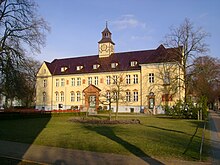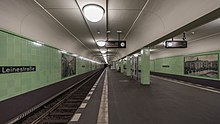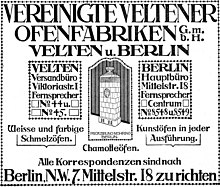History of the pottery industry in Velten
The history of the pottery industry in Velten shows the boom and decline of the pottery industry in the Brandenburg town of Velten .
Starting position
In the early 19th century was a pure Velten arable village with about 300 inhabitants and the typical local Anger , around which twelve Hofwirtschaften and the village church around clustered. The typical building of this time was the Märkisches Mittelflurhaus made of clay walls and covered with reeds.
The clay deposits as a starting point
The clay deposits west of Velten in the so-called Pötterberg mountains had been known since the Middle Ages and were sporadically mined. The farmers on whose land they were had no special knowledge of clay mining, so the yield remained low. They sold the clay to potteries in the area and to Berlin . Brick bakers and burners also relied on him. The clay was sieved and cleaned in a clay slurry before further processing. Friedrich Blumberg has specialized in this process since 1833 . Due to the high demand, a second slurry mill was opened in 1840, by Christian Krause. During this time, the finished clay was taken to the Havel near Hohenschöpping in horse-drawn vehicles and loaded onto ships. From here he was brought to the Feilner furnace factory in Berlin. The entrepreneur Tobias Christoph Feilner had developed a white enamel glaze that combined particularly well with stove tiles made from Velten clay. The reason for this was the high lime content and the correct shrinkage of the clay after firing. With these white enamel tiles, in the strict classical tradition, Feilner produced the white Berlin enamel tiled stove, a bestseller of the time.
The first furnace factories




On July 7th, 1835, the authorities approved the plans of the master mason Johann Ackermann to build a pottery factory at 35 Breiten Str. 35 (today No. 46 ( Lage )) . Three years later the factory employed 12 potters and 15 workers and produced 300 white Berlin stoves. 12,000 bricks were also delivered. Having become aware of the economic success, further furnace factories were built
- 1843 in the Breiten Straße 33-34 the furnace factory Wartenberg ( location )
- In 1858 the F. Könnecke furnace factory in Breiten Straße 5
- In 1860 at Friedrichstrasse 31 (today's Rosa Luxemburg Strasse) the stove factory Eckhard, Rheins, Fläming and Spindler
By 1865, twelve stove factories in Velten produced stove tiles (8 × 9 inches = 21 × 23.5 cm) in different colors and quality levels. The price for a white Berlin stove was 24 thalers . Since the clay deposits also contained poor quality clay, many kiln factories produced bricks as a by-product. Later, several brick factories were built that mainly produced yellow brickwork . As a practical matter, some of them were used on site to set up new furnace factories.
Founding period
After the establishment of the German Empire in 1871, there was a construction boom in Germany, which also spurred the furnace industry. 17 new furnace factories were built between 1871 and 1878. During this phase, the furnace factory A. Schmidt, Lehmann und Co ( Lage ) was the only furnace factory that still produces in Velten today. Now it happened in quick succession. In 1894 the stock grew to 34 stove factories with more than 2000 employees, which produced around 60,000 tiled stoves. The white Berlin smelter tiled stove was still the main product because it could not be produced in this good quality elsewhere. In the meantime it cost 72 marks . The main market was the nearby Berlin, to which the goods were brought in horse-drawn vehicles. Throughout Germany and as far as the Russian Empire , the tiles were brought by ship from the Havel near Hohenschöpping.
The second street was Viktoriastraße, which was built on from 1858. Others, such as Friedrichstrasse (now Rosa Luxemburg Strasse), Kochstrasse, Bergstrasse and Wilhelmstrasse were added. The farmers who owned the land quickly became rich and some of them founded furnace factories themselves. These quickly changed the townscape. In addition to ten stove factories, several factory owners' houses with magnificent stucco facades, which the Veltener Töppervillen called the Veltener Töppervillen , were built in the Breite Strasse . The number of residential buildings rose from 69 to 351 between 1859 and 1894, with just under 7,000 inhabitants. Most of the people in the surrounding villages of Marwitz , Bötzow , Eichstädt , Vehlefanz and Hennigsdorf also made their living from the Velten furnace industry.
At the end of the 19th century, workers usually worked eleven hours a day, six days a week. In addition, the work was hazardous to health due to clay dust and toxic glazes containing lead. After a strike involving more than 1,000 workers, the daily working time dropped to ten hours. The piece rate was 2.95 marks for 100 tiles and 4.80 marks for 100 corners.
The culmination
The last three furnace factories in Velten were established at the beginning of the 20th century. It was them
- Furnace factory Netzband & Co in Kreisbahnstraße 8 ( location )
- Oven factory Hermann Gustav Zirner in the Breiten Straße 1a ( location )
- Cooperative company H. Lehmann & Co in Viktoriastraße 35 ( location )
The stove factory Blumenfeld, under the management of Richard Blumenfeld , was transformed in 1905 into the first stock company of all Velten stove factories. This year the Velten stove factories reached their peak with 100,000 stoves produced.
The decline
From 1905 to 1910 to 1912, furnace production fell from 100,000 to 67,500 to 52,500. The merger of 33 Veltener Ofenfabriken to form the Vereinigte Ofenfabriken GmbH did nothing to change this . This should exclude mutual competition and achieve higher prices. Even the newly built port , which offered good water connections to the main market in Berlin via the Velten branch canal , could not prevent a severe crisis from occurring in 1913, which resulted in several furnace factories having to close.
In 1917, as a result of the First World War, the entire furnace industry in Velten was shut down, the workforce was drafted into the military or allowed to work in the army workshops in Spandau .
After the First World War, 25 furnace factories resumed production. Richard Blumenfeld AG gradually succeeded in taking over several competitors until it was the largest company in town in 1925.
The Velten-Vordamm stoneware factories were among the best-known companies. The Velten part of the business, newly built in 1913, was to produce wall panels. After the war, art, building and utility ceramics were produced. Well-known Bauhaus ceramists such as Theodor Bogler and Werner Burri worked in Velten-Vordamm, and Thoma Grote and Charles Crodel in the field of building ceramics . Ceramicists such as Charlotte Hartmann, Else Dörr, Luise Harkort , Margerete Heymann and Hedwig Bollhagen also left their mark here. This company, which was successful in the first third of the 20th century, had to file for bankruptcy in 1931 as a result of the effects of the global economic crisis .
At the beginning of the 1930s there were still 15 furnace factories in Velten, 5 of which belonged to Richard Blumenfeld AG. A total of 570 people were still employed in the furnace factories. The increasing, cheaper competition from abroad and the newly emerging central heating made the stove factories difficult.
time of the nationalsocialism
During the National Socialist era , the Jewish entrepreneur Richard Blumenfeld was forced out of office as chairman of the stock corporation and the factory was renamed Veltag, Veltener Ofen- und Keramik AG . In spite of all of this, the centenary of the Velten stove tile industry was celebrated in 1935. The community, which now has 9,000 inhabitants, also received town charter that year. The green tiled stove appeared for the first time on the new city coat of arms and the lettering Heimat des tiled stove was attached to the sign at the entrance to the town. At the beginning of the Second World War , the Veltag was classified as an important military operation. Nevertheless, the workforce and the number of skilled workers decreased. One consequence of this was that the quality fell and the delivery time was two to four months, and later even more. Forced laborers from the Soviet Union were also used at the Veltag in 1944 .
Soviet occupation zone and GDR
After the war, the furnace factories resumed production despite partial dismantling by the Soviet authorities. However, on January 1st, 1947, the Veltag was expropriated, assigned to VEB Steine-Erden and later renamed VVB Glas-Keramik Werk Kachelfabrik Veltak . Some other furnace factories were grouped under the VEB furnace tiles and ceramics .
In 1968 there was a tiled stove share of 84% in the GDR. Accordingly, the state invested in Veltak in 1961 , in which 325 workers worked in shifts to produce 60 tons of tile ware. This made it the largest tile factory in Europe. Special designs were exported to Austria, Sweden or Canada for foreign currency .
Turning time
The Veltak had a few years after the turn of cease production. Today in Velten there is only Schmidt, Lehmann & Co. GmbH at Wilhelmstrasse 32, which manufactures stove tiles and building ceramics. The Velten Oven and Ceramics Museum is located on the top two floors . Today the city of Velten is officially called Ofenstadt.
Traces of the past
There are still many buildings in Velten whose use was originally related to the pottery industry. Some of them are protected as architectural monuments.
- Former factory owners' houses
- Former workers' houses
- Former furnace factories
- Furnace factory Netzband
- Karl Sensse furnace factory
- Furnace factory A. Schmidt, Lehmann & Co
References
literature
- Paul Dahms: Velten, A foray through the history of the furnace city , Veltener Verlagsgesellschaft mbH, ISBN 978-3-9811401-8-7 .
- Formed Dried Burned, Märkische Bricks for Berlin - An exhibition of the Friends of the Oven and Ceramic Museum Velten eV 1997. The Friends of the Oven and Ceramic Museum, Velten 1996 ( building block. Vol. 3).
- Perfection of the simple: Hedwig Bollhagen turns ninety - An exhibition of the Friends of the Oven and Ceramics Museum Velten eV 1997. The Friends of the Oven and Ceramics Museum, Velten 1997 ( Module. Vol. 5).
- Nicole Seydewitz (Ed.), KunstKeramik der Moderne. For the 150th birthday of the Velten stove and ceramics entrepreneur Richard Blumenfeld . VV Veltener Verlagsgesellschaft, Velten 2013, ISBN 978-3-9813649-8-9 .
See also
History of the pottery industry in Marwitz
Web links
Individual evidence
- ↑ Paul Dahms: Velten, A foray through the history of the furnace city , p. 17.
- ↑ Restaurator im Handwerk 1/2009 p. 30 ( Memento of the original from January 20, 2015 in the Internet Archive ) Info: The archive link was inserted automatically and has not yet been checked. Please check the original and archive link according to the instructions and then remove this notice. (PDF; 5.5 MB), accessed on February 7, 2011.
- ↑ Formed, dried, burned, Märkische Ziegel für Berlin , p. 10.
- ↑ Ofenfabrik A. Schmidt, Lehmann & Co. GmbH ( Memento of the original from April 17, 2011 in the Internet Archive ) Info: The archive link was inserted automatically and has not yet been checked. Please check the original and archive link according to the instructions and then remove this notice. , accessed February 7, 2011.
- ↑ Paul Dahms: Velten, A foray through the history of the oven city , pp. 30–34.
- ↑ Paul Dahms: Velten, Ein Streifzug durch die Geschichte der Ofenstadt , pp. 36–39.
- ↑ Paul Dahms: Velten, Ein Streifzug durch die Geschichte der Ofenstadt , pp. 59–61.
- ↑ Paul Dahms: Velten, Ein Streifzug durch die Geschichte der Ofenstadt , pp. 63–64.
- ↑ Paul Dahms: Velten, A foray through the history of the furnace city , p. 64.
- ↑ Paul Dahms: Velten, A foray through the history of the furnace city , p. 73.
- ↑ Hedwig Bollhagen turns ninety , pp. 6-7.
- ↑ Paul Dahms: Velten, Ein Streifzug durch die Geschichte der Ofenstadt , pp. 91–94.
- ↑ Paul Dahms: Velten, Ein Streifzug durch die Geschichte der Ofenstadt , pp. 98–99.
- ↑ Paul Dahms: Velten, A foray through the history of the furnace city , pp. 108-109.
- ^ Oven and Ceramics Museum Velten , accessed on February 7, 2011.





